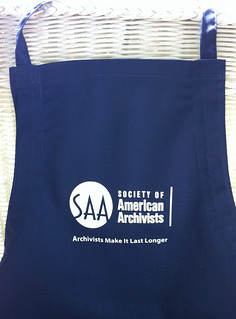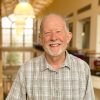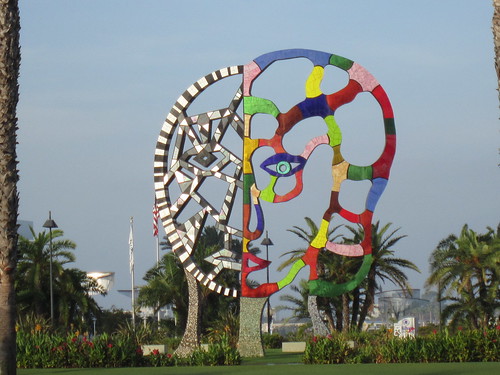This article is more than 5 years old.
My experience at SAA this year in San Diego was excellent and filled with sessions about preservation-related topics. I kept thinking the whole time I was there- “Craig you might have found your niche”.
Over the past year, the Preservation Section of SAA has been working on a fund raiser for the SAA Disaster Relief Fund. We decided on selling aprons (for the kitchen or the archive) and I was given the job of designing the image on the aprons. We sold 91 out of 100 of the aprons sending $920 to the SAA Disaster Relief Fund-so this was a real success.
In the Opening Plenary, David Ferriero, Archivist of the United States, emphasized three points: a new records management initiative by the Obama administration, a convergence of skills for librarians and archivists to build a skill set for the future (think GLAM) and the Digital Public Library of America.
The Plenary speech was given by Jon Voss, the Strategic Partnerships Director for History Pin. After exclaiming that he was using a Mac and he was a huge fan of archivists, he made the statement that ‘linked data’ or coming out of the card catalog is where the internet revolution began. Using linked data and taking a tip from the ‘mash-up culture’, History Pin has created some great content. Mr. Voss touted the site we are what we do as an example. This site sells products that have a built in ‘good behavior’ attached to their use. Voss also showed some History Pin samples, such as a Dorthea Lange photo of Japanese-Americans being removed during WWII and a current photo. He also mentioned a San Francisco project called pastmapper. which uses online maps to create to help describe the past in certain geographic areas. In saying that linked open data helps us move beyond tables to graphs, Voss showed the site civilwardata150.net which uses archival material and RDF (Resource Description Framework) data to make connections such as this one with the First Regiment Michigan Infantry, 102nd U.S. Colored Troops. Another innovative use of these tools is conflicthistory.com which uses maps to show conflict locations and basic information on these events.
“Partnerships New and Old: Preservation in the 21st Century” was my first session, which was moderated by Shannon Zachery, University of Michigan Library Preservation. Much of this dealt with the preservation of digital elements as preservation (digital copies of materials and media and preservation metadata). Preservation job descriptions currently ask for both hand skills and technical skills for digital preservation. Some institutions are actually creating the hybrid position of digital archivist. Many institutions are struggling with digital preservation since there is no clear standard for file formats or storage methods at this time. (although the ALA/ALCTS/Preservation Reformatting Section is drafting a document). In addition, few universities are actually using the cloud for storage. This session actually made me feel good because we are in a similar situation as many institutions.
I enjoyed a wonderful lunch after this session with our former friend and colleague, Audra Yun, Katie Nash from Elon and Rebecca Petersen.
“Taking Stock and Making Hay: Archival Collections Assessment in Action” was the next session moderated by Merrilee Proffitt of OCLC Research. In this session, Jennifer Waxman, Center for Jewish History, described a collections survey project she led at NYU. The project used graduate students to survey 5000 containers using a relational database to store the data. This project identified over 50% of the containers that needed remediation for slumped or overstuffed folders. Ben Goldman from Penn State made the case for the urgency to preserve legacy media and born digital materials in our collections. Lisa Callahan, University of Chicago, Black Metropolis Research Consortium argued for the access to African-American research material to create discovery of hidden collections. Martha O’Hara Conway, University of Michigan Special Collections Library described a project using graduate students from the School of Information to process unprocessed collections which helped the library, as well as build confidence in the students.
During the Preservation Section meeting, a panel discussed “Preservation in the 21st Century”. Michele Cloonan, Dean of Simmons College Graduate School of Library and Information Science gave a short history of preservation education. Michele mentioned the landmark acts that got preservation on the map in the 1930’s such as establishment of the National Archives(1934), the Rome Conference of the League of Nations, the Athens Charter, and the Historic Sites Act. The general tenor of the discussion was the evolution of preservation skills from hands-on to stronger IT skills. In the words of Karen Gracy from Kent State: “Preservation professionals should become as familiar with the structure of digital materials as they have been with paper-based materials.”
On Friday morning, I attended a session on greater collaboration with Wikipedia moderated by Karen B. Weiss, Archives of American Art. A discussion was held on the value of “Wikipedian in Residence”. At NARA and the Smithsonian, they have successfully used this program to build community and to use their fans for transcribing documents. By building community, they try to engage people by holding events like a “Scan-a-thon” where volunteers scan and describe images that have never been scanned before. In this way, using a hybrid model of volunteers and professionals, these institutions attempt to get their holdings out to people more efficiently. Some institutions are also holding “Edit-a-thons” where volunteers work together to edit Wikipedia entries from the institution holding the event. These are unique and innovative programs to be more of your holdings out.
My final session was moderated by Kara McClurken, Head of Preservation Services at UVA, and was entitled “Favorite Collaborative Tools for Preservation.” These tools were presented in a lightning round format and included: Conducting a Condition Survey; Environmental Monitoring; Using the Lyrasis Pocket Response Plan; the Costep Coordinated Statewide Emergency Preparedness program for cultural institutions in the northeast; and using social media to recover lost items (Hauls of Shame, Facebook at NARA, Flickr at Denver Public Library )
This conference was extremely positive in many ways: networking with other preservation and archival professionals, learning what people are up to, getting involved in a great organization and seeing a new city. Can’t beat that!


5 Comments on ‘Beyond Borders- Society of American Archivists-2012’
So great to hear about SAA from a preservation perspective. Thanks, Craig!
I am glad you have found your people!
I’m not surprised that a digital focus is emerging for preservation. Also, the sculpture at the top of your post (“Coming Together” by Niki de Saint Phalle) was one of my favorite landmarks when we were at ALA last year!
So glad you and Rebecca got to go and bring back some great ideas. Nice work on the aprons, too. 🙂
What an honor to be asked to design the apron… and they are great..not that we expect anything less from our Craig…